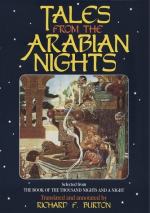[FN#23] Compare the description of the elephant-faced Vetala (Katha S.S. Fasc. xi. p. 388).
[FN#24] The lover’s name Sa’ik= the Striker (with lightning); Najmah, the beloved= the star.
[FN#25] I have modified the last three lines of the Mac. Edit. which contain a repetition evidently introduced by the carelessness of the copyist.
[FN#26] The Hindu Charvakas explain the Triad, Bramha, Vishnu and Shiva, by the sexual organs and upon Vishnu’s having four arms they gloss, “At the time of sexual intercourse, each man and woman has as many.” (Dabistan ii. 202.) This is the Eastern view of Rabelais’ “beast with two backs.”
[FN#27] Arab. “Rabbat-i,” my she Lord, fire (nar) being feminine.
[FN#28] The prose-rhyme is answerable for this galimatias.
[FN#29] A common phrase equivalent to our “started from his head.”
[FN#30] Arab. “Mariduna"=rebels (against Allah and his orders).
[FN#31] Arab. Yafis or Yafat. He had eleven sons and was entitled Abu al-Turk because this one engendered the Turcomans as others did the Chinese, Scythians, Slaves (Saklab), Gog, Magog, and the Muscovites or Russians. According to the Moslems there was a rapid falling off in size amongst this family. Noah’s grave at Karak (the Ruin) a suburb of Zahlah, in La Brocquiere’s “Valley of Noah, where the Ark was built,” is 104 ft. 10 in. Iong by 8 ft. 8 in. broad. (N.B.—It is a bit of the old aqueduct which Mr. Porter, the learned author of the “Giant Cities of Bashan,” quotes as a “traditional memorial of primeval giants”—talibus carduis pascuntur asini!). Nabi Ham measures only 9 ft. 6 in. between headstone and tombstone, being in fact about as long as his father was broad.
[FN#32] See Night dcliv., vol. vii, p. 43, infra.
[FN#33] According to Turcoman legends (evidently pose-Mohammedan) Noah gave his son, Japhet a stone inscribed with the Greatest Name, and it had the virtue of bringing on or driving off rain. The Moghuls long preserved the tradition and hence probably the sword.
[FN#34] This expresses Moslem sentiment; the convert to Al-Islam being theoretically respected and practically despised. The Turks call him a “Burma"=twister, a turncoat, and no one either trusts him or believes in his sincerity.
[FN#35] The name of the city first appears here: it is found also in the Bul. Edit., vol. ii. p. 132.
[FN#36] Arab. " ’Amala hilah,” a Syro-Egyptian vulgarism.
[FN#37] i.e. his cousin, but he will not use the word.
[FN#38] Arab. “La’ab,” meaning very serious use of the sword: we still preserve the old “sword-play.”
[FN#39] Arab. " Ikhsa,” from a root meaning to drive away a dog.
[FN#40] Arab. “Hazza-hu,” the quivering motion given to the “Harbak” (a light throw-spear or javelin) before it leaves the hand.
[FN#41] Here the translator must either order the sequence of the sentences or follow the rhyme.




